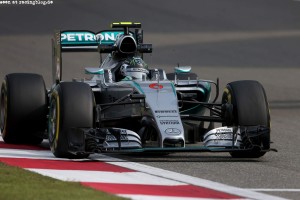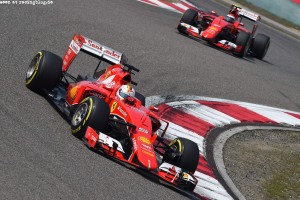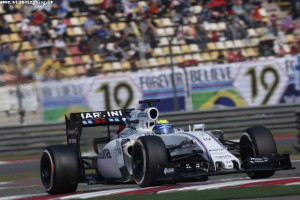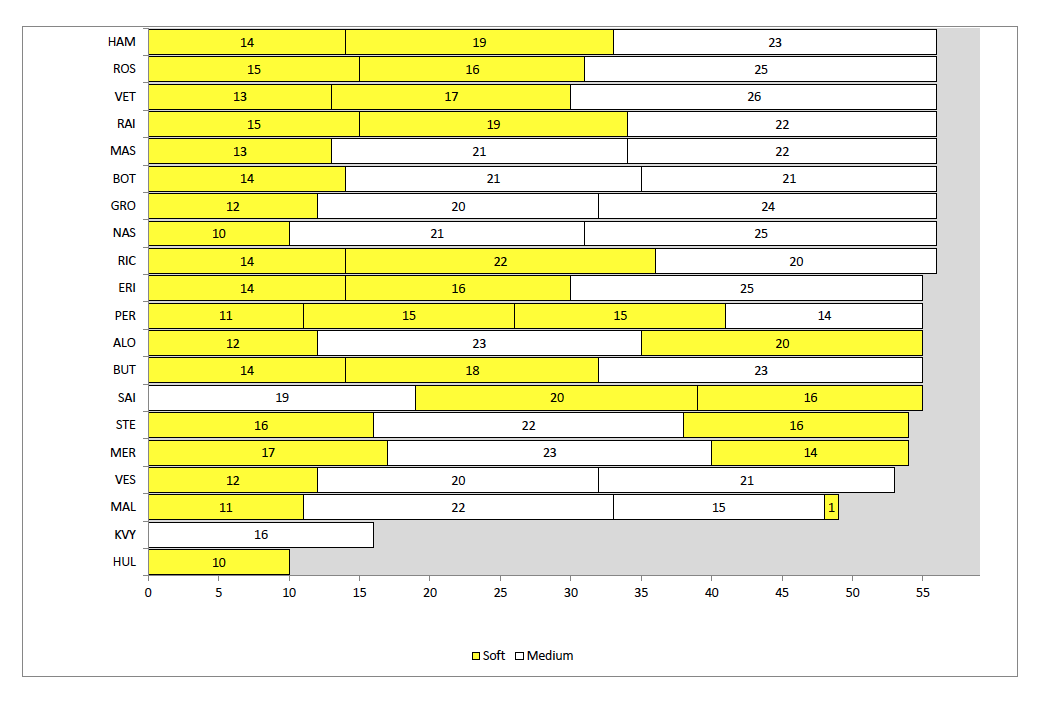Race Strategy again played a role in creating the main talking point of Sunday’s Chinese Grand Prix. There was some controversy after the race between the two Mercedes drivers over the allegation by Nico Rosberg that Lewis Hamilton had put him into a strategically compromised situation, relative to Ferrari’s Sebastian Vettel.
 In fact the renewed competitiveness of Vettel and Ferrari is a problem for Rosberg, but not for the reasons he was highlighting on Sunday night. Last year Mercedes had a significant pace advantage over its rivals, which meant that the team strategists could experiment with different strategies for their car running in second place to give him a chance to win the race. This happened at most venues and led to some great races, like Bahrain and Spain, as well as some later in the season like Austin and Brazil.
In fact the renewed competitiveness of Vettel and Ferrari is a problem for Rosberg, but not for the reasons he was highlighting on Sunday night. Last year Mercedes had a significant pace advantage over its rivals, which meant that the team strategists could experiment with different strategies for their car running in second place to give him a chance to win the race. This happened at most venues and led to some great races, like Bahrain and Spain, as well as some later in the season like Austin and Brazil.
The problem with Ferrari being closer to the Mercedes on race pace this year is not what Rosberg saw as the threat of being undercut by Vettel as a result of Hamilton running slowly in the middle stint to save tyres and bunching the field up as a result.
In China, unlike Malaysia, Mercedes had the pace to see off that challenge and in any case the Ferrari struggled to warm up the harder medium tyres, so Vettel’s first lap out of the pits on them did not have the explosive pace to make the undercut work.
The problem for Rosberg is that there is not the scope for two widely differing strategies this year between the Mercedes drivers, because Vettel is close enough that if one of the strategies went wrong, the team would not get a 1-2 finish, in fact it might even lose the race. It is one thing to switch one driver onto a different tyre for the second stint if you are racing yourselves with the third place car 8 or 10 seconds behind. But quite another if Vettel is sitting 1.6 seconds behind in third place at the end of the opening stint.
This puts more emphasis on qualifying and the start of the race, which is why Rosberg was so deflated after missing pole by 4/100ths of a second on Saturday and why Hamilton had his car pointed at an aggressive angle on the start line, aiming across at Rosberg to cut off any challenge into Turn 1.
Rosberg implied after the race that he was looking to pass Hamilton at the end, as was the plan last season with the varying strategies, but it was never likely to happen here. And not because of Hamilton’s pace in the middle stint backing Rosberg into the Ferraris.
 What we are seeing this year – and China was a good example – is that it is difficult to overtake if you are running a comparable strategy to your opponent and you have not got a significant offset in the tyre life. The cars cannot follow each other closely without damaging their tyres by overheating them, so they have to sit behind at a distance and a few laps more or less life on a set of tyres isn’t enough with these 2015 Pirellis to create sufficient pace advantage to pass.
What we are seeing this year – and China was a good example – is that it is difficult to overtake if you are running a comparable strategy to your opponent and you have not got a significant offset in the tyre life. The cars cannot follow each other closely without damaging their tyres by overheating them, so they have to sit behind at a distance and a few laps more or less life on a set of tyres isn’t enough with these 2015 Pirellis to create sufficient pace advantage to pass.
Kimi Raikkonen’s race was a good example; the Finn qualified behind the Williams cars, but passed them both on the opening lap. He was now running behind his team mate on the same soft tyres. So he tried to offset himself against Vettel by running two laps longer in the first stint and four laps longer in the second. Last year that might have meant something.
But here it wasn’t enough to make any real difference. Overtaking in Shanghai is easy on the main straight, but it relies on getting better traction out of the long Turn 13, which leads onto the straight, than your opponent. And this comes from having a fresher set of tyres, or a faster compound of tyres, than your opponent.
Raikkonen said that the Safety Car’s emergence at the end spoiled his chance of an overtake, but Vettel had enough pace to have him covered anyway. Raikkonen would have needed soft tyres or eight or more laps of tyre life difference on the mediums to have any chance.
Everyone is being responsive, not sticking to plan
That said, the Pirelli soft tyres do still tend to hit a “cliff”, where the performance drops off suddenly. Mercedes was conscious of this from Friday practice where Hamilton got about 12 laps out of a set of softs in a long run before the lap times started to go off by a couple of seconds per lap. It looked like they may have some issues with higher degradation than Ferrari.
So there was a real art to managing the tyres on Sunday, to make sure that you had long enough first and second stints – ideally 14 and 16 laps respectively – so that you didn’t leave yourself with too long a stint on mediums at the end. About 25 laps was ideal.
 Teams were making their decisions after around 8 laps of the race, once they could see where their cars were placed and what the pace of the two tyres was. It was clear that the medium was a good bit slower, but after losing the start to Raikkonen, Williams chose a different strategy and opted to use the mediums for the second and third stints on both cars as they were simply racing against themselves and the mediums gave them greater flexibility in the event of a mid race Safety Car, for example.
Teams were making their decisions after around 8 laps of the race, once they could see where their cars were placed and what the pace of the two tyres was. It was clear that the medium was a good bit slower, but after losing the start to Raikkonen, Williams chose a different strategy and opted to use the mediums for the second and third stints on both cars as they were simply racing against themselves and the mediums gave them greater flexibility in the event of a mid race Safety Car, for example.
This reflects a wider approach in the field of teams not having clarity on how the tyres will perform in the race and so playing it by ear.
If Mercedes had had a bigger gap to Ferrari they would probably have done the same Soft/Medium/Medium strategy as Williams, or more likely spit the strategies to give both drivers a chance to race at the end.



